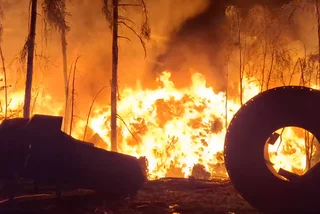Air quality in the Czech Republic has been improving. Concentrations of air pollutants in 2021 were at their lowest to second lowest levels in the last 10 years, according to preliminary data from the Czech Hydrometeorological Institute (ČHMÚ). The overall levels, though, did not beat 2020, which had the best air quality since measurements began in the 1990s.
The data so far is only from automated measuring stations. It took into account dust and fine dust particles in the air, ground-level ozone, nitrogen dioxide, carbon monoxide, and sulfur dioxide. Manual measurements of heavy metals, benzene, or other pollutants will not be evaluated until April.
“The evaluation based on the air quality index shows that the air quality in 2021 was mostly very good to good. The occurrence of very good to good air quality at urban and suburban stations occurred most often in the South Bohemian, Plzeň, and the South Moravia regions excluding the Brno area, and least often in the Ostrava / Karviná / Frýdek-Místek (O/K/FM) area,” ČHMÚ stated in its report.
“At rural stations, very good to good air quality occurred most often in the South Moravian Region excluding the Brno area, and least often again in the O/K/FM area,” ČHMÚ added.
Compared to the 10-year average of 2011–20, most of the months in 2021 had standard conditions for the dispersal of dust (particles measuring 10 microns, called PM10) and fine dust (particles measuring 2.5 microns, called PM2.5). The exceptions were May with significantly better dispersal conditions and February with worsened conditions.
Legal limits for dust and fine dust were exceeded at only a few stations in the Ostrava, Karviná, and Frýdek-Místek regions, as well as at a station in the Zlín region. Limits for ground-level ozone were also exceeded mainly at stations at higher altitudes and in the Ústí nad Labem Region. Elevated ozone concentrations are typical for these areas.
The average monthly concentrations of nitrogen dioxide were lower last year than the 10-year average in all months of the year, while dust and fine dust particles were below average all year except for June.
The relatively low concentrations of fine particles and nitrogen dioxide in 2021 can be attributed to continuing reductions in emissions due to ongoing measures to improve air quality, favorable meteorological conditions without drought in the warmer part of the year, and more favorable dispersal conditions at the end of the year compared to the 10-year average, ČHMÚ stated.
Last year, as in 2020, air quality was also affected by government measures against the coronavirus pandemic. This was especially the case in March when a ban on movement between districts was in effect. While there was a decrease in air pollutants from transport, there were also higher emissions from domestic heating as the population stayed home, ČHMÚ pointed out.
“In the case of nitrogen dioxide, which is mainly caused by transport, it can be assumed that under normal situations without protective measures against coronavirus, nitrogen dioxide concentrations would have been higher,” ČHMÚ pointed out.
Dust levels, which depend on many factors, would likely have been unchanged by the anti-Covid restrictions.
In 2021, the 24-hour limit for dust (PM10) was exceeded at four stations out of a total of 118. All stations were located in the O/K/FM area. The limit for the average annual concentrations of dust was not exceeded at any station in the Czech Republic in 2021, for the third time in a row after 2019 and 2020. One smog situation, lasting 58 hours, was announced in December in the O/K/FM area.
The annual concentration limit for fine dust (PM 2.5) was exceeded at 10 out of 86 stations. Nine were located in the O/K/FM area, and one in the Zlín region.
Nitrogen dioxide limits were not exceeded at any station in the Czech Republic in 2021 for the second time since measurements began in the 1990s. The other time was 2020.
The second part of the preliminary report, which assesses concentrations of the carcinogen benzo[a]pyrene, will be published in April. Benzo[a]pyrene is a hydrocarbon that results from the incomplete combustion of organic matter. It can be found in coal tar, tobacco smoke, and many foods, especially grilled meats, and is listed as a Group 1 carcinogen by the International Agency for Research on Cancer (IARC).
“For this substance, as in previous years, excesses of the annual emission limit can be expected at a number of locations, particularly in association with emissions from local heating systems,” ČHMÚ said.












 Reading time: 3 minutes
Reading time: 3 minutes 































